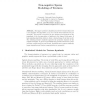Free Online Productivity Tools
i2Speak
i2Symbol
i2OCR
iTex2Img
iWeb2Print
iWeb2Shot
i2Type
iPdf2Split
iPdf2Merge
i2Bopomofo
i2Arabic
i2Style
i2Image
i2PDF
iLatex2Rtf
Sci2ools
SCALESPACE
2007
Springer
2007
Springer
Non-negative Sparse Modeling of Textures
This paper presents a statistical model for textures that uses a non-negative decomposition on a set of local atoms learned from an exemplar. This model is described by the variances and kurtosis of the marginals of the decomposition of patches in the learned dictionary. A fast sampling algorithm allows to draw a typical image from this model. The resulting texture synthesis captures the geometric features of the original exemplar. To speed up synthesis and generate structures of various sizes, a multi-scale process is used. Applications to texture synthesis, image inpainting and texture segmentation are presented. 1 Statistical Models for Texture Synthesis The characterization of textures is a central topic in computer vision and graphics, mainly approached from a probabilistic point of view. Spatial domain modeling. The works of both Efros and Leung [1] and Wei and Levoy [2] pioneered a whole area of greedy approaches to texture synthesis. These methods copy pixels one by one, enforc...
Related Content
| Added | 09 Jun 2010 |
| Updated | 09 Jun 2010 |
| Type | Conference |
| Year | 2007 |
| Where | SCALESPACE |
| Authors | Gabriel Peyré |
Comments (0)

